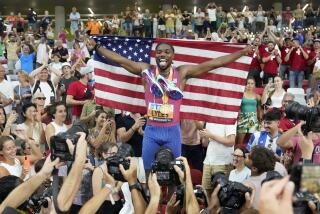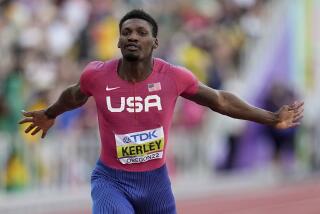Musyoki Waits to Make His Move, Wins : Racing: Pace is slow, but Kenyan pulls away with 100 meters left to take Arturo Barrios Invitational.
- Share via
CHULA VISTA — Figure it out: Kenyan distance runner William Musyoki placed sixth in the Youngstown, Ohio, 10-kilometer road race with a disappointing time of 28 minutes 35 seconds. Then he came West and, on Sunday, finished the Arturo Barrios Invitational in 28:42--and won.
Must have been a significant drop in the quality of the field, right? Wrong.
“The competition was much stronger today,” Musyoki insisted after the victory, which he pulled out with 100 meters to go as he breezed past leaders Ed Eyestone and Gerardo Alcala, both of whom thought they had only each other to worry about, and earn the winner’s check of $4,000.
“Yeah, it looked like it was just going to be between the two of us and then all of a sudden the Moose-man goes flying by,” Eyestone said.
Alcala, from Mexico City, and Eyestone, who resides in Layton, Utah, finished second and third, respectively, with identical marks of 28:43.
The field not only included Eyestone, who one week before set an American best at 25-kilometers by a full minute (1:14:37), and Herrera, one of many strong distance runners who train in Mexico City’s high altitude, but also featured such notables as Olympian Brian Abshire; local favorite Thom Hunt, who had won two 10Ks earlier this year, and Rolando Vera, another strong distance runner from Mexico.
For Musyoki, the major difference between sixth place a week before and first place Sunday was the pace.
The men’s race started slow and crept along almost at a marathon pace. It took the leaders 4:48 to finish the first mile.
The reason for the lethargy was simple: No one wanted to take the lead and take on the wind for the benefit of those behind him on a blustery day along the Chula Vista harbor.
“It was really windy,” said Eyestone. “And when you get into a windy race, no one really is willing to go out and break the wind. It takes guts and it takes a lot out of you.”
Just ask Hunt, who tried to go out early and break away after the first mile, but later paid for it and finished out of the top 10.
On this day the smart thing to do was to tuck behind the leaders and draft.
And that’s what most of the elite runners did. During the first loop of the three-loop course, the lead pack consisted of 24 runners, all jostling for a spot somewhere behind the other guys.
The race quickly turned into a war of attrition. At the start of the second loop, only 12 runners survived in the lead pack. That number was eight at the start of the final loop and six with a half-mile to go.
It was about that time that Musyoki realized he could kick past the leaders.
“I know I have a lot of speed,” Musyoki said. “And if I’m still with the leaders toward the end, I know I can finish (among the top three).”
Musyoki again pointed out he had enough reserve energy because of the slow pace.
“The pace was very comfortable for me,” he said. “I didn’t want to push the pace and then pay for it at the end. . . . I felt I could have gone a lot farther--I didn’t get tired at all.”
The women’s race, too, was very tactical. After two miles, the lead pack still numbered seven runners. It remained that way with a half mile to go when the pack finally began to string out.
The final sprint was won by Wilma Van Onna of the Netherlands in 33:24, only a second faster than the time of second-place Ulla Marquette of Canada. Michelle Bush-Cuke, the American record-holder at 20 kilometers (1:08:20), was third at 33:30.
The winner of each race received $4,000, with $2,400 going to second-place finishers and $1,200 to third-place runners.
More to Read
Go beyond the scoreboard
Get the latest on L.A.'s teams in the daily Sports Report newsletter.
You may occasionally receive promotional content from the Los Angeles Times.






